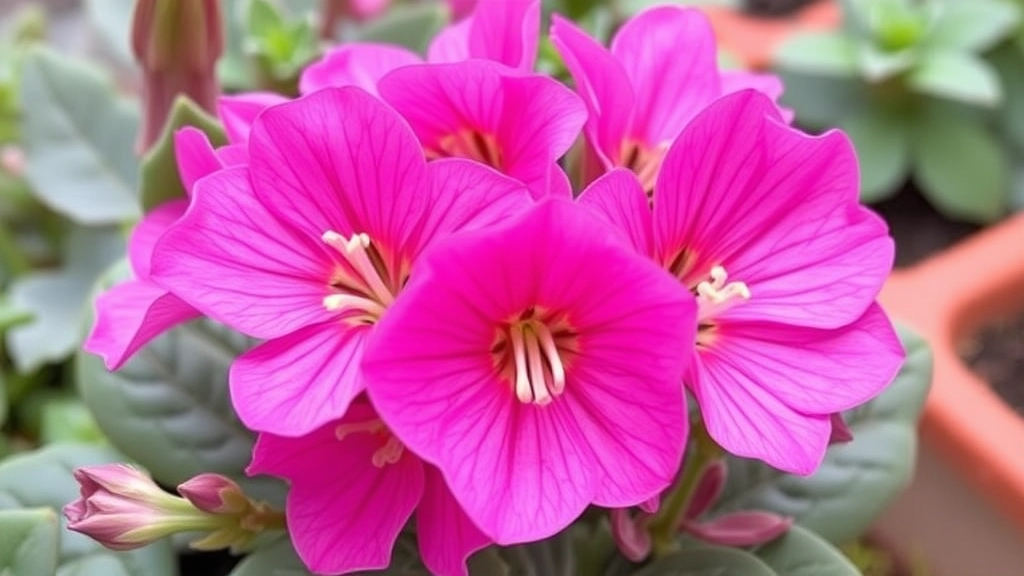Mastering Kalanchoe Blossfeldiana Poelln Care
If you’re looking to master Kalanchoe Blossfeldiana Poelln care, you’ve come to the right place. This vibrant succulent, known for its stunning flowers and easy maintenance, is a favourite among both novice and seasoned gardeners. Let’s dive into the essentials, from the best light conditions to watering guidelines, to keep your plant thriving.
Optimal Growth Conditions
For optimal growth, place your Kalanchoe in bright, indirect light. Watering should be infrequent but thorough, ensuring the soil is well-drained to prevent root rot. Understanding these basics will set you on the path to enjoying a healthy, blooming Kalanchoe Blossfeldiana Poelln all year round.
Best Light Conditions for Kalanchoe Blossfeldiana
When it comes to nurturing Kalanchoe Blossfeldiana, light conditions play a pivotal role in its growth and blooming potential. You might wonder why your plant isn’t thriving or flowering as expected.
Optimal Light Exposure
Kalanchoe Blossfeldiana flourishes best in bright, indirect sunlight. Here’s what you need to keep in mind:
- Direct Sunlight: While Kalanchoe can tolerate some direct sunlight, too much can scorch its leaves. Aim for about 4-6 hours of morning sun.
- Filtered Light: A south or west-facing window is ideal. If the light is too harsh, consider using sheer curtains to diffuse it.
- Low Light: If your plant is in a low-light environment, it may become leggy and produce fewer flowers.
Signs of Adequate Light
How do you know if your plant is getting enough light? Look for these indicators:
- Vibrant Leaves: Healthy, green leaves indicate good light exposure.
- Robust Growth: A compact shape with new growth suggests your plant is happy.
- Blooming: Regular blooming cycles are a sign that your Kalanchoe is receiving the light it craves.
Adjusting Light Conditions
If your plant isn’t performing well, consider adjusting its location.
- Rotation: Rotate your plant every few weeks to ensure even light distribution.
- Seasonal Changes: Be mindful of seasonal variations. You may need to move your plant closer to the light during darker months.
For more detailed guidance on ensuring your Kalanchoe Blossfeldiana thrives, check out our Optimal Care for Kalanchoe Blossfeldiana Growth page. Additionally, if you are curious about the best soil to use for your plant, visit our Best Soil for Kalanchoe Blossfeldiana guide.
Watering Guidelines for Healthy Growth
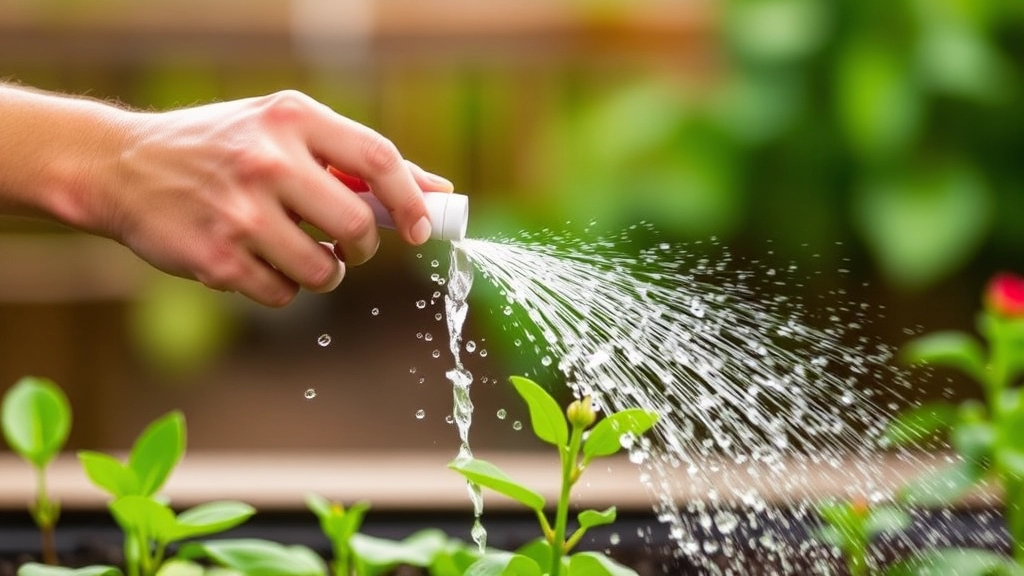
So, you’ve got your Kalanchoe Blossfeldiana, and you’re probably wondering how much water it really needs.
Watering Woes? Let’s Sort It Out!
Overwatering is a common pitfall for many plant lovers.
These beauties prefer their soil to dry out between waterings.
Here’s a simple guide to keep your Kalanchoe thriving:
- Check the Soil: Stick your finger about an inch into the soil. If it feels dry, it’s time to water.
- Watering Frequency: Generally, every two to three weeks is a good rule of thumb, but this can vary based on your home’s humidity and temperature.
- Watering Technique: When you do water, soak the soil thoroughly until it drains out of the bottom. This ensures the roots get the moisture they need.
- Seasonal Changes: In winter, reduce watering as the plant goes dormant.
- Signs of Trouble: Yellowing leaves? That could mean too much water. Conversely, if the leaves are shrivelling, it’s a sign it’s time for a drink!
Keeping these tips in mind will help you avoid common watering mistakes and ensure your Kalanchoe stays healthy and vibrant.
Soil Requirements and Repotting Tips
When it comes to growing Kalanchoe Blossfeldiana, the right soil is crucial for its health and blooming potential. Many plant enthusiasts often worry about the best soil mix to use.
Ideal Soil Mix
Kalanchoe thrives in well-draining soil. A mix that retains some moisture but allows excess water to escape is essential. Here’s what you should consider:
- Cactus or Succulent Mix: These pre-made mixes are ideal as they provide excellent drainage.
- DIY Soil Mix: Combine:
- 50% potting soil
- 25% perlite or coarse sand
- 25% pine bark or coconut coir
This combination encourages airflow to the roots and prevents waterlogging. For more detailed information, check out the best soil for Kalanchoe Blossfeldiana care tips.
Repotting Tips
Repotting your Kalanchoe can seem daunting, but it’s a straightforward process. Here are some tips to ensure a smooth transition:
- Timing: Repot in spring when the plant is actively growing.
- Choose the Right Pot: Select a pot that is one size larger than the current one, with drainage holes.
- Gently Remove the Plant: Carefully take the plant out, loosening the soil around the roots.
- Inspect Roots: Trim any dead or rotting roots to promote healthy growth.
- Fill with Fresh Soil: Place the plant in the new pot and fill with your chosen soil mix, ensuring it’s stable.
By following these soil and repotting guidelines, you’ll set your Kalanchoe up for robust growth and vibrant blooms. For more tips on ensuring optimal growth, visit our guide on optimal care for Kalanchoe Blossfeldiana growth.
Encouraging Blooming and Reblooming Techniques for Kalanchoe Blossfeldiana
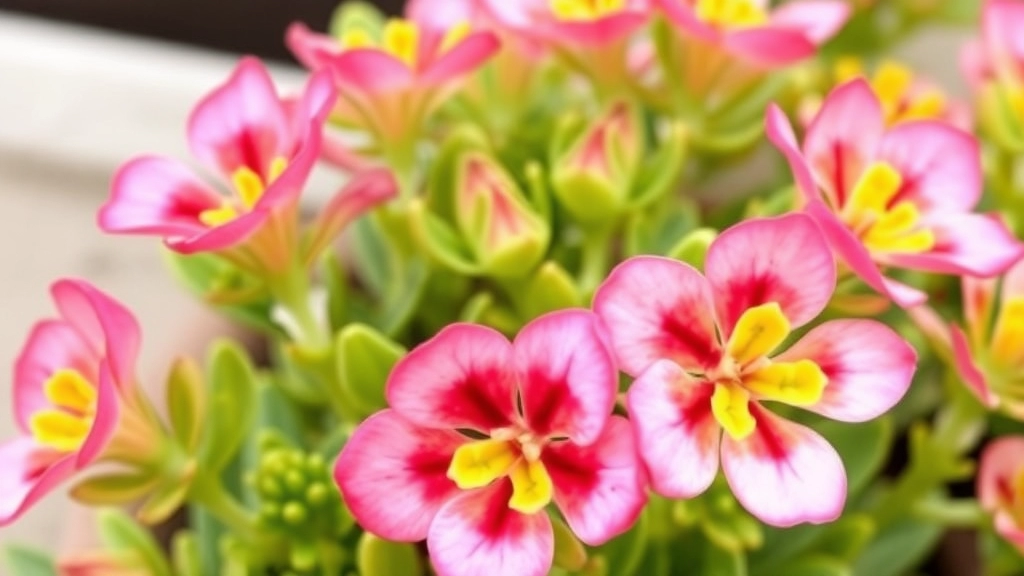
As we explore the best practices for nurturing your Kalanchoe Blossfeldiana, it’s essential to focus on how to encourage blooming and reblooming. Many plant enthusiasts often wonder why their Kalanchoe isn’t flowering as expected or how to coax it back into bloom after its initial display.
Understanding the Blooming Cycle
Kalanchoe Blossfeldiana typically blooms in cycles, with the right care making all the difference. Here are some effective techniques to encourage those vibrant flowers:
1. Light Exposure
- Bright, Indirect Light: Ensure your plant receives plenty of bright, indirect sunlight. This is crucial for promoting blooming.
- Avoid Direct Sunlight: Too much direct sunlight can scorch the leaves, hindering blooming.
2. Watering Practices
- Allow Drying Between Watering: Kalanchoe prefers to dry out between waterings. Overwatering can lead to root rot and reduce flowering.
- Water Sparingly During Dormancy: In the winter months, reduce watering to encourage the plant to rest and prepare for the next blooming cycle.
3. Pruning
- Deadhead Spent Blooms: Regularly remove spent flowers to encourage new growth and prolong blooming.
- Trim Back After Blooming: After the blooming period, prune back the stems to promote bushier growth.
4. Temperature Management
- Maintain Consistent Temperatures: Kalanchoe thrives in temperatures between 18-24°C (65-75°F). Sudden temperature changes can stress the plant and affect blooming.
5. Encouraging Reblooming
- Dark Periods: For reblooming, provide a period of darkness. Cover the plant for 14-16 hours a day for about 6 weeks. This mimics its natural environment and can trigger another blooming cycle.
- Fertilisation: Use a balanced fertiliser every 4-6 weeks during the growing season to provide essential nutrients.
Common Pests and How to Manage Them
As we delve into the care of Kalanchoe Blossfeldiana, it’s essential to address a common concern among plant enthusiasts: pests.
Identifying Common Pests
Kalanchoes can attract several pests, which can hinder their growth and blooming potential. Here are the most common culprits:
- Mealybugs: These tiny, white, cotton-like insects often cluster in leaf joints and on stems.
- Aphids: Small, green or black insects that can cause leaf curl and stunted growth.
- Spider Mites: Tiny, spider-like pests that create fine webbing on the plant, especially in dry conditions.
- Scale Insects: Brown or tan bumps that adhere to stems and leaves, sucking sap from the plant.
Effective Management Strategies
Managing these pests is crucial for maintaining a healthy Kalanchoe. Here are some effective methods:
- Regular Inspection: Check your plants weekly for any signs of pests. Early detection is key.
- Natural Remedies: Use a mixture of water and mild soap to spray affected areas. This can help dislodge pests without harming the plant.
- Neem Oil: This natural pesticide can be effective against many pests. Apply it according to the product instructions.
- Isolation: If you notice any infested plants, isolate them to prevent the spread of pests to healthy plants.
- Encourage Beneficial Insects: Ladybugs and lacewings can help control pest populations naturally.
Prevention is Key
To prevent infestations, maintain optimal growing conditions:
- Ensure proper air circulation around your plants.
- Avoid overwatering, which can create a humid environment conducive to pests.
- Keep your Kalanchoe clean by wiping leaves with a damp cloth to remove dust and potential eggs.
By staying vigilant and proactive, you can protect your Kalanchoe Blossfeldiana from pests and ensure it thrives. For more detailed care instructions, check out our guide on optimal care for Kalanchoe Blossfeldiana growth and learn about the best leaf care tips and troubleshooting methods.
Temperature Sensitivity and Cold Protection
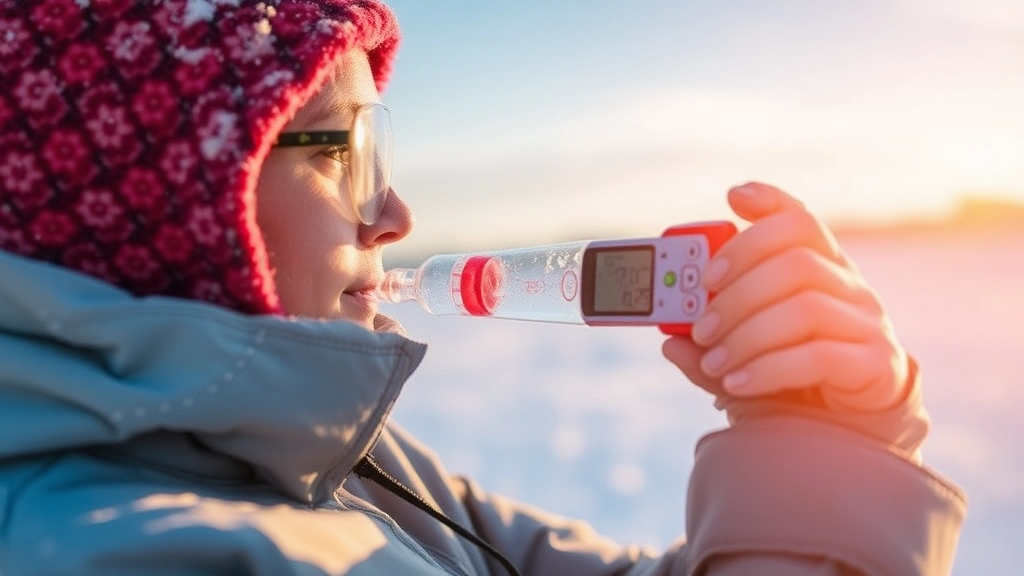
Ever found yourself worried about your Kalanchoe Blossfeldiana when the temperature dips? You’re not alone! These vibrant little beauties thrive in warm conditions, but they can be quite sensitive to the cold.
Ideal Temperature Range
- Optimal Temperature: Kalanchoes prefer temperatures between 20°C to 25°C (68°F to 77°F).
- Minimum Tolerance: They can tolerate temperatures as low as 10°C (50°F), but anything below that can stress them out.
Signs of Temperature Stress
Keep an eye out for these signs that your Kalanchoe might be feeling the chill:
- Wilting Leaves: If the leaves start drooping, it might be too cold.
- Discolouration: Look for yellowing or browning on the edges of the leaves.
- Stunted Growth: If your plant isn’t growing as it should, it might be time to check the temperature.
Cold Protection Tips
So, how can you keep your Kalanchoe safe from the cold? Here are some easy tips:
- Bring Indoors: If the temperature drops, bring your plant inside.
- Use a Grow Light: This can help maintain warmth during chilly nights.
- Cover with a Cloth: If you must leave them outside, cover them with a lightweight cloth during cold snaps.
- Avoid Drafts: Keep your Kalanchoe away from windows and doors where cold air can sneak in.
Seasonal Considerations
- Winter Care: During winter, ensure your Kalanchoe is in a warm spot, ideally near a window with plenty of sunlight.
- Acclimatise Gradually: If you’re moving your plant outside for the summer, do it gradually to help it adjust to the temperature changes.
Propagation Methods: Cuttings, Offsets, and Seeds
As we explore how to keep your Kalanchoe Blossfeldiana thriving, understanding propagation methods is essential for expanding your collection or sharing with friends.
Cuttings
One of the most popular ways to propagate Kalanchoe is through cuttings. This method is straightforward and effective. Here’s how to do it:
- Select a Healthy Stem: Choose a stem that is healthy and free of pests or disease.
- Make the Cut: Using clean, sharp scissors, cut a stem about 10-15 cm long, ensuring it has a few leaves.
- Let it Callous: Place the cutting in a dry, warm spot for a few days to allow the cut end to callous over.
- Planting: Once calloused, plant the cutting in well-draining soil, burying the cut end about 2-3 cm deep.
- Watering: Lightly water the soil, and avoid overwatering until roots develop.
Offsets
Kalanchoe can also produce offsets, which are small plantlets that grow from the base of the parent plant. These can be an easy way to propagate:
- Identify Offsets: Look for small plantlets around the base of the mother plant.
- Remove Carefully: Gently twist or cut the offset away from the parent plant.
- Potting: Plant the offset in its own pot with well-draining soil.
- Care: Water lightly and place it in bright, indirect light until it establishes.
Seeds
While less common for Kalanchoe, you can also propagate from seeds. This method requires a bit more patience:
- Seed Collection: If your plant has flowered, you can collect seeds after the flowers have dried.
- Sowing: Scatter the seeds on the surface of moist, well-draining soil and lightly press them down.
- Humidity: Cover with plastic wrap to maintain humidity until germination occurs.
- Light: Once seedlings appear, remove the cover and place them in bright light.
Propagation not only allows you to expand your Kalanchoe collection but also fosters a deeper connection with your plants. For more detailed guidance, check out our guide on propagating Kalanchoe Blossfeldiana cuttings and our tips on growing Kalanchoe Blossfeldiana from seeds.
Fertilization Strategies for Optimal Flowering
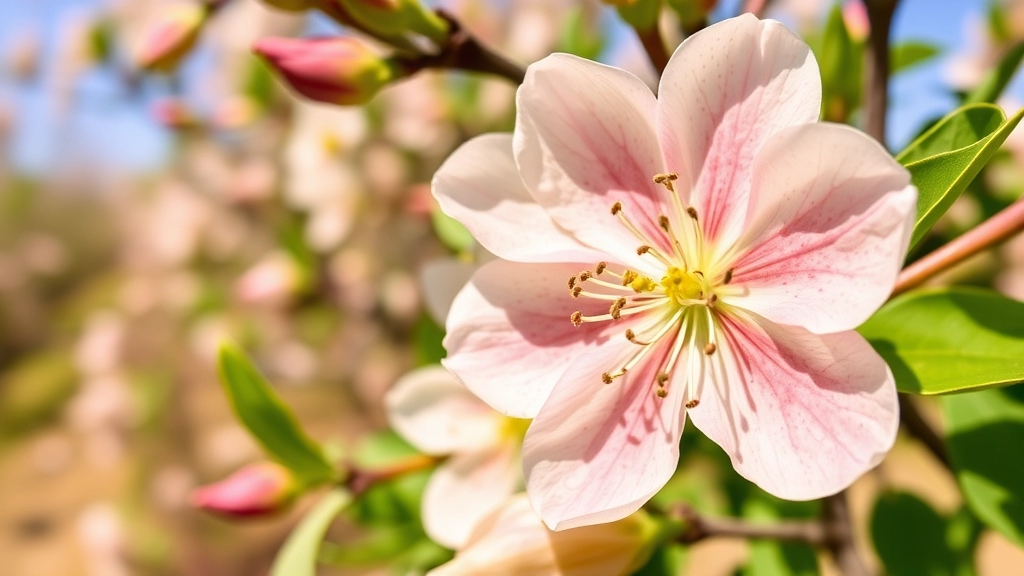
So, you’ve got your Kalanchoe Blossfeldiana thriving, but how do you get those stunning blooms to really shine?
Fertilization is key.
When to Fertilize:
- Growing Season: Focus on spring and summer when your plant is actively growing.
- Frequency: Every 4-6 weeks is a good rule of thumb.
What to Use:
- Balanced Fertilizer: Look for a balanced, water-soluble fertilizer (like 20-20-20).
- Dilution: Always dilute it to half strength to avoid burning those delicate roots.
How to Apply:
- Watering First: Give your plant a good drink before applying fertilizer. This helps prevent root burn.
- Even Distribution: Pour the diluted fertilizer evenly around the base of the plant.
Signs Your Plant Needs More:
- Pale Leaves: If the leaves start to look a bit washed out, it’s a signal for more nutrients.
- Reduced Blooms: Fewer flowers? Time to up your fertilization game.
Additional Tips:
- Switch it Up: Consider using a bloom booster formula as you approach blooming season.
- Organic Options: If you prefer natural methods, try fish emulsion or seaweed extract.
Preventing Root Rot and Other Common Diseases
Are you worried about your Kalanchoe Blossfeldiana wilting or showing signs of distress? Root rot is a common issue that can devastate your plant if not addressed promptly.
Understanding Root Rot
Root rot typically occurs when the roots are submerged in water for too long. This leads to fungal infections that can damage the plant irreparably. Here are some signs to watch for:
- Yellowing leaves: A clear indicator that your plant may be suffering.
- Soft, mushy roots: Healthy roots should be firm and white.
- Foul odour: A rotten smell emanating from the soil can be a warning sign.
Prevention Tips
To keep your Kalanchoe healthy and thriving, consider these practical steps:
- Well-draining soil: Use a cactus or succulent mix that allows excess water to escape. For more tips, check out our best soil for Kalanchoe Blossfeldiana care tips.
- Pot with drainage holes: Ensure your container has adequate drainage to prevent water accumulation.
- Watering schedule: Allow the soil to dry out completely between waterings. Check the top inch of soil before adding more water.
- Humidity control: Kalanchoes prefer dry conditions, so avoid overly humid environments.
Addressing Other Common Diseases
In addition to root rot, Kalanchoes can face other health issues, such as:
- Powdery mildew: This white powdery substance can appear on leaves. Increase air circulation and avoid overhead watering to combat it.
- Leaf spot: Brown spots on leaves can indicate a fungal infection. Remove affected leaves and ensure proper spacing between plants. For more on maintaining healthy leaves, see our leaf care tips and troubleshooting guide.
Quick Recap
- Use well-draining soil and pots with drainage holes.
- Water only when the soil is dry.
- Monitor for signs of disease and act quickly.
Frequently Asked Questions (FAQs) about Kalanchoe Blossfeldiana Poelln Care
How often should I water my Kalanchoe Blossfeldiana?
Generally, you should water your Kalanchoe every two to three weeks. Ensure the soil dries out between waterings to avoid overwatering, which can lead to root rot.
What is the best way to water Kalanchoe Blossfeldiana?
When watering, soak the soil thoroughly until it drains out of the bottom. This ensures that the roots receive adequate moisture.
How can I encourage my Kalanchoe to bloom?
Ensure your plant gets plenty of bright, indirect sunlight, allow the soil to dry out between waterings, and maintain consistent temperatures. Prune spent blooms and provide periods of darkness to trigger reblooming.
What are the ideal temperature conditions for Kalanchoe Blossfeldiana?
Kalanchoes thrive in temperatures between 20°C to 25°C (68°F to 77°F). They can tolerate temperatures as low as 10°C (50°F), but anything below that can cause stress.
How can I protect my Kalanchoe from cold weather?
Bring your plant indoors if the temperature drops, use a grow light to maintain warmth, cover the plant with a lightweight cloth during cold snaps, and keep it away from drafts.
When and how should I fertilize my Kalanchoe Blossfeldiana?
Fertilize during the growing season (spring and summer) every 4-6 weeks using a balanced, water-soluble fertilizer diluted to half strength. Water the plant before applying fertilizer to prevent root burn.
What type of light does Kalanchoe Blossfeldiana need?
Kalanchoe Blossfeldiana prefers bright, indirect light. Avoid placing it in direct sunlight as it can scorch the leaves.
How can I tell if my Kalanchoe is overwatered or underwatered?
Yellowing leaves typically indicate overwatering, while shriveling leaves suggest that the plant needs more water.
What are some signs that my Kalanchoe is stressed by temperature changes?
Signs of temperature stress include wilting leaves, discolored leaves (yellowing or browning), and stunted growth.
Can I use organic fertilizers for my Kalanchoe Blossfeldiana?
Yes, organic options like fish emulsion or seaweed extract can be used. These natural methods can provide essential nutrients without the risk of chemical burn.
How do I prune my Kalanchoe to encourage more blooms?
Regularly deadhead spent blooms and trim back the stems after the blooming period to promote bushier growth and encourage new flowers.
Why is my Kalanchoe not blooming?
Lack of blooming can be due to insufficient light, improper watering, or temperature fluctuations. Ensure your plant receives bright, indirect light, allow the soil to dry out between waterings, and maintain a stable temperature.
References
-
Kalanchoe Blossfeldiana Growing Guide
-
Kalanchoe Plant Care
-
Kalanchoe: How to Grow and Care for Kalanchoe Plants
